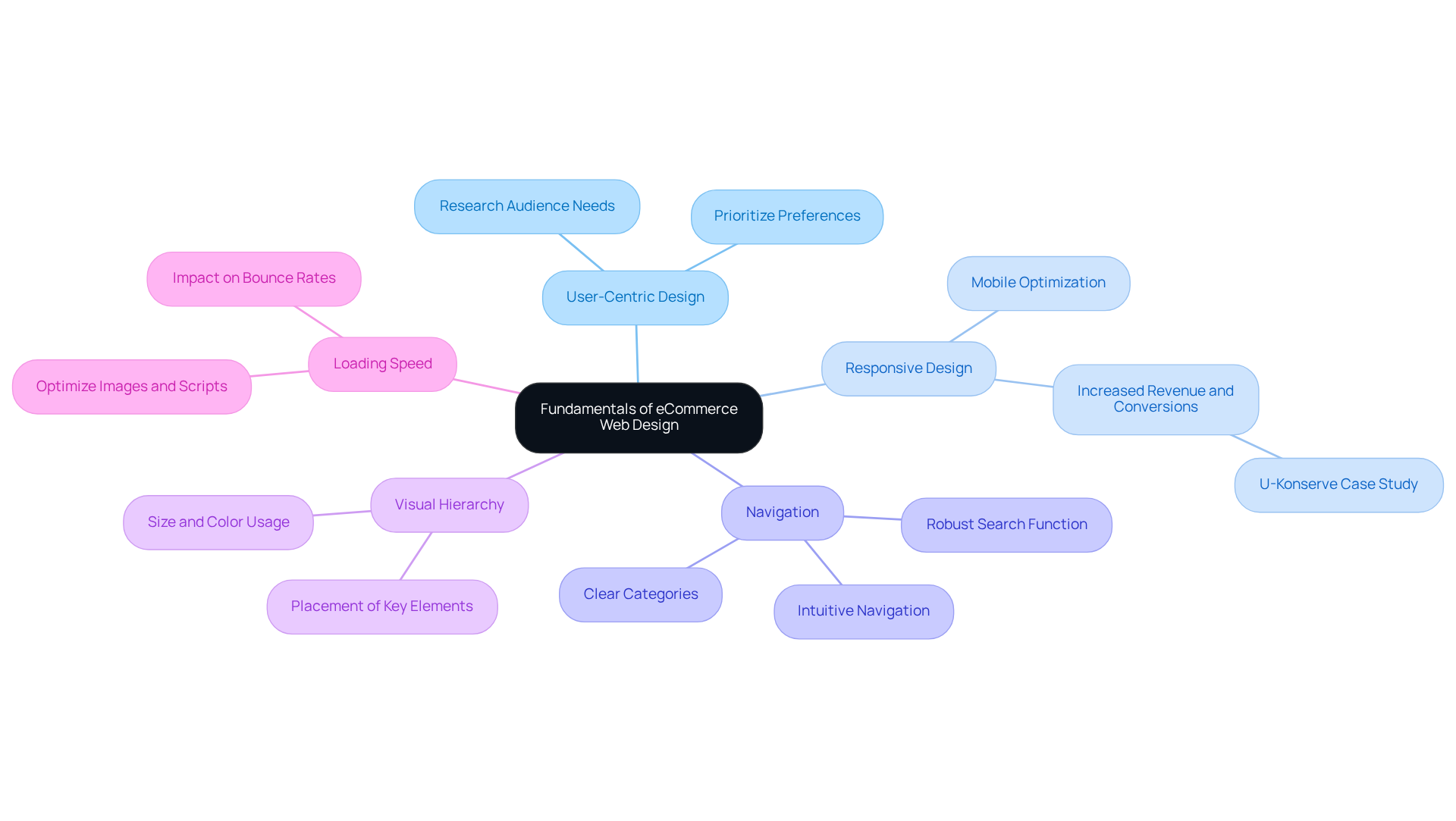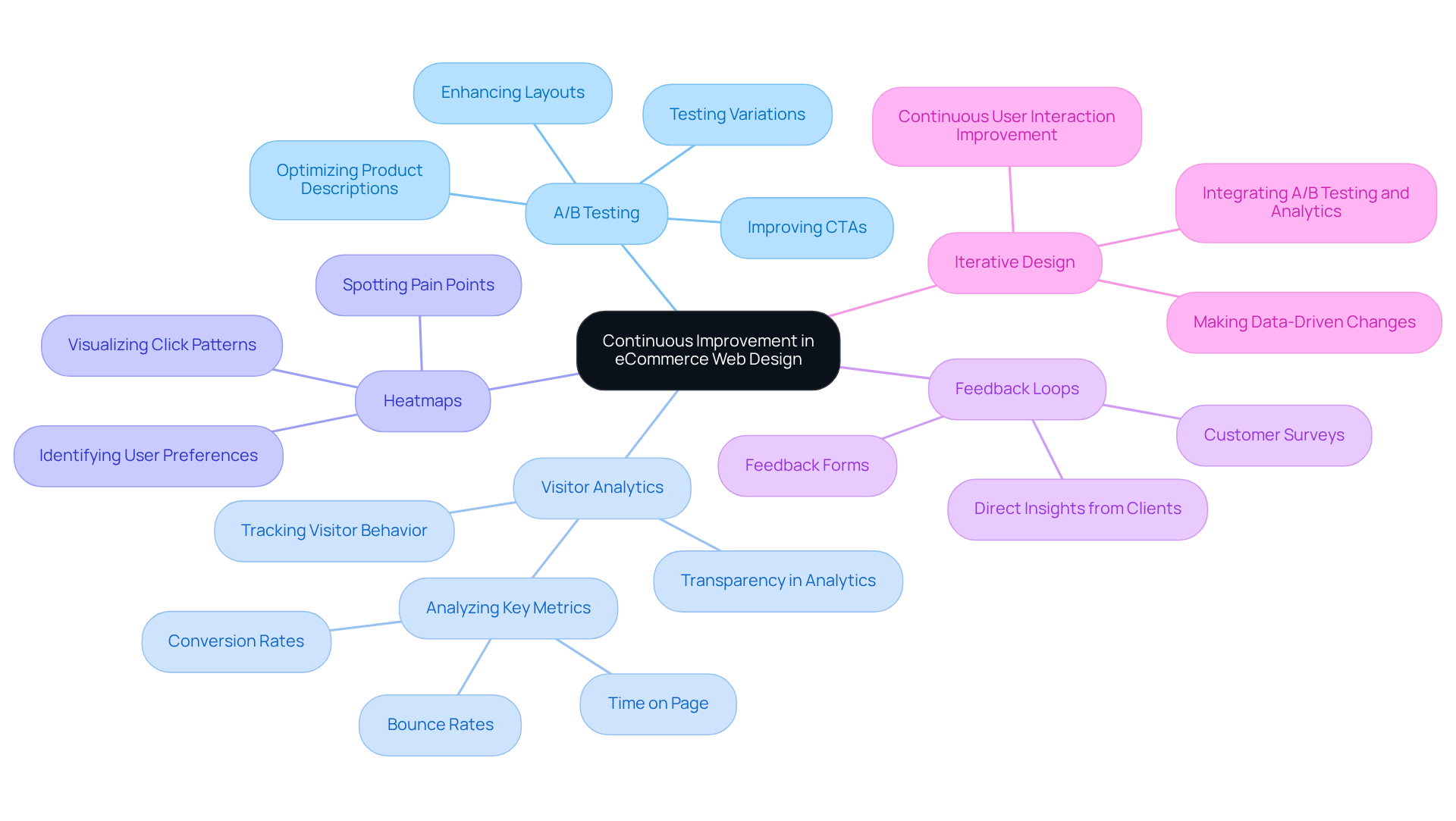
Overview
This article is dedicated to mastering eCommerce web design, a critical factor in enhancing user experience. It emphasizes essential elements such as:
- User-centric design
- Responsive layouts
- Effective navigation
Evidence supports the assertion that improved sales and conversions stem from strategic implementations like:
- High-quality images
- Clear calls to action
- Regular A/B testing
These design principles are not merely suggestions; they are proven contributors to customer satisfaction and overall business success. By understanding and applying these concepts, businesses can significantly elevate their online presence and drive meaningful results.
Introduction
In a digital landscape where online shopping continues to surge, the design of eCommerce websites plays a pivotal role in shaping user experiences and driving sales. Mastering the art of eCommerce web design not only enhances customer satisfaction but also strategically positions brands for success in an increasingly competitive market.
However, with rapid advancements in technology and shifting consumer expectations, businesses must ensure their designs remain effective and engaging.
This article delves into essential design principles and innovative strategies that empower brands to create optimal user experiences, ultimately leading to higher conversions and lasting customer loyalty.
Understand the Fundamentals of eCommerce Web Design
To excel in eCommerce web design, focusing on foundational elements is essential:
- : Prioritize the needs and preferences of your target audience. Conduct comprehensive research to gain insights into their behaviors and expectations, ensuring that your creation resonates with them.
- Responsive Design: With mobile devices accounting for a significant share of online shopping, implementing a responsive design is crucial. Studies reveal that U-Konserve achieved a remarkable 161% rise in revenue and a 153% increase in conversions after enhancing their strategies, underscoring the effectiveness of mobile-friendly sites in engaging visitors.
- Navigation: Create intuitive navigation that allows individuals to find products effortlessly. Clear categories and a robust search function are vital for improving the overall experience, making it easier for customers to locate what they need.
- Visual Hierarchy: Utilize size, color, and placement strategically to guide attention to key elements, such as calls to action (CTAs) and product images. A well-organized visual hierarchy can significantly influence decisions and enhance results.
- Loading Speed: Optimize images and scripts to ensure swift loading times. Research indicates that even a slight delay can lead to increased bounce rates, emphasizing the importance of speed in retaining potential customers.
In the words of Jeff Bezos, founder of Amazon, "Your most unhappy customers are your greatest source of learning." By mastering these fundamentals, brands can establish a solid foundation for their eCommerce web designing, which enhances customer satisfaction and drives sales. Moreover, avoiding common pitfalls, such as neglecting mobile optimization or complicating navigation, is critical to maintaining overall satisfaction. By concentrating on these key areas, brands can anticipate improved customer retention and increased sales.

Implement Key Design Elements for Enhanced User Experience
To enhance user experience and drive conversions, it is imperative to implement the following key design elements:
- High-Quality Images: Utilize professional, high-resolution images that effectively showcase products. Ensure images are zoomable and provide multiple angles, allowing users to gain a comprehensive view of the items.
- Clear Calls to Action (CTAs): Design prominent and compelling CTAs using contrasting colors and actionable language. Research indicates that clear CTAs can significantly enhance response rates, with a remarkable 129% rise noted for a Fortune 1000 auto parts eCommerce site. This underscores their essential role in effective e commerce web designing.
- Trust Signals: Incorporate elements such as customer reviews, testimonials, and security badges to with potential buyers. Studies reveal that displaying trust signals can lead to increased consumer confidence and higher conversion rates, with a 35.4% increase in conversions achieved by adding TrustPilot reviews to booking pages.
- Consistent Branding: Maintain a cohesive color scheme, typography, and style throughout the website to reinforce brand identity. Consistency in branding not only enhances customer satisfaction but also fosters brand loyalty.
- Accessible Design: Ensure the website is accessible to all users, including those with disabilities. Implement features like alt text for images and keyboard navigability to create an inclusive shopping environment.
By concentrating on these visual aspects, brands can cultivate a more captivating and user-friendly experience through e commerce web designing that effectively boosts sales and improves overall profitability. For instance, a jewelry eCommerce brand achieved a 24% conversion increase through A/B testing of their visual components, illustrating the tangible benefits of implementing these strategies.

Utilize A/B Testing and Analytics for Continuous Improvement
To foster continuous improvement in your e commerce web designing, it is essential to implement effective strategies that drive results.
- A/B Testing: Regularly testing different versions of web pages is crucial for identifying which elements yield better performance. This includes experimenting with variations in calls-to-action (CTAs), layouts, and product descriptions to enhance engagement. Companies employing A/B testing can significantly improve their success rates, especially as eCommerce is forecasted to reach $7.4 trillion in sales by 2025.
- Visitor Analytics: Utilizing tools such as Google Analytics allows you to on your site. Key metrics—bounce rates, time on page, and conversion rates—provide valuable insights into user interactions, aiding in the identification of trends and areas needing enhancement. Notably, a survey indicates that 80% of consumers are more likely to trust companies that share data supporting their sustainability claims, underscoring the importance of transparency in analytics.
- Heatmaps: Employing heatmap tools to visualize clicks and navigation patterns uncovers user preferences and potential pain points. This information enables focused enhancements in site layout. For instance, the "Ecommerce Conversion Metrics Optimization" case study illustrates how ongoing optimization efforts can lead to substantial increases in profitability.
- Feedback Loops: Establishing customer feedback mechanisms, such as surveys or feedback forms, is vital for gathering direct insights from clients regarding their experiences. This qualitative information directs modifications and feature improvements, ensuring that user needs are effectively addressed.
- Iterative Design: Embracing an iterative design approach—making changes based on testing and analytics—encourages continuous improvement of visitor interactions. This strategy guarantees that the site evolves in response to audience requirements. By integrating A/B testing and user analytics, brands can cultivate a culture of continuous improvement in e commerce web designing that significantly enhances user experience and drives higher conversion rates.

Conclusion
Mastering eCommerce web design is essential for crafting a seamless user experience that not only attracts visitors but also converts them into loyal customers. By emphasizing user-centric design, responsive layouts, intuitive navigation, and vital visual elements, brands can significantly elevate their online presence and drive sales. Prioritizing these foundational aspects guarantees that the website resonates with the target audience, ultimately resulting in enhanced customer satisfaction and retention.
The article underscores several key strategies for optimizing eCommerce web design, highlighting the significance of:
- High-quality images
- Clear calls to action
- Trust signals
- Consistent branding
- Accessible design
Each of these components plays a crucial role in developing an engaging user experience that fosters conversions. Furthermore, implementing A/B testing and utilizing analytics tools encourages continuous improvement, enabling brands to adjust their strategies based on user behavior and feedback.
In an ever-evolving digital landscape, the importance of effective eCommerce web design is paramount. Brands must adopt these best practices to remain competitive and meet the dynamic expectations of consumers. By committing to user-centric design principles and leveraging data-driven insights, businesses can create an online shopping experience that not only meets but surpasses customer expectations, paving the way for sustained growth and success in the eCommerce arena.
Frequently Asked Questions
What is the importance of user-centric design in eCommerce web design?
User-centric design is essential as it prioritizes the needs and preferences of the target audience. Conducting comprehensive research helps gain insights into their behaviors and expectations, ensuring that the website resonates with them.
Why is responsive design crucial for eCommerce websites?
Responsive design is crucial because a significant share of online shopping occurs on mobile devices. Implementing a mobile-friendly site can lead to increased engagement, as demonstrated by U-Konserve, which saw a 161% rise in revenue and a 153% increase in conversions after enhancing their strategies.
How can effective navigation improve the eCommerce experience?
Effective navigation creates an intuitive experience that allows customers to find products effortlessly. Clear categories and a robust search function are vital for improving the overall experience and helping customers locate what they need.
What role does visual hierarchy play in eCommerce web design?
Visual hierarchy utilizes size, color, and placement to guide attention to key elements, such as calls to action (CTAs) and product images. A well-organized visual hierarchy can significantly influence customer decisions and enhance overall results.
Why is loading speed important for eCommerce websites?
Loading speed is important because optimizing images and scripts ensures swift loading times. Research indicates that even slight delays can lead to increased bounce rates, which emphasizes the necessity of speed in retaining potential customers.
What common pitfalls should be avoided in eCommerce web design?
Common pitfalls to avoid include neglecting mobile optimization and complicating navigation. These issues can negatively impact overall customer satisfaction and retention.
How can mastering eCommerce web design fundamentals impact sales?
Mastering eCommerce web design fundamentals enhances customer satisfaction, drives sales, and improves customer retention by focusing on key areas that matter to users.
FAQs











